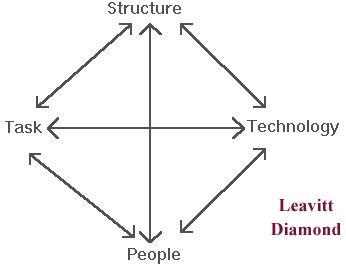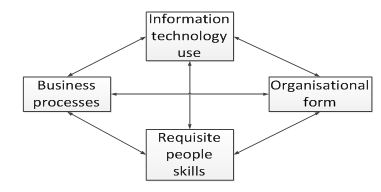Dynamics CRM, Change Management and the Leavitt Diamond
John Eccles, 10 August 2011
Understanding of the Leavitt Diamond is essential for successful implementation of a CRM (or XRM) system.

Leavitt Diamond
Dr Harold Leavitt was one of the great management thinkers of the 20th century. He wrote, Managerial Psychology in 1958, which is still a classic in management literature. Leavitt developed what came to be known as the Leavitt Diamond to illustrate the complex nature of social systems. In this model, every organizational system is made up of four main components: People, Task(s), Structure and Technology. It is the interaction between these four components that determines the fate of an organization. Leavitt’s diamond is thus an integrated approach and is widely used for managing organizational change.
Leavitt emphasized that changing one of these elements has a direct effect on all other elements, and thus they will also need to be adjusted to accommodate the change. Otherwise, when one element such as Technology is changed, the other components will often adjust to minimise the impact of the innovation.
Application to CRM Technology
An adaption of the original Leavitt diagram has been used to illustrate the dynamic elements involved in changes to organizational processes.
(Redesigning Enterprise Processes for e-Business, El Sawy, Omar A, 2001)

The key lesson is this:
It’s not just about the technology!
Introduction of a CRM system, or any new information technology, requires careful consideration of the associated business processes, people involved and the organizational structure.
Business Processes
Business processes may need to be re-designed to accommodate the new information technology. In many cases larger gains are made by changing the process than by making the existing process more efficient. In a good CRM system, whole tasks can be fully automated and work removed completely from the process.
Another example of process change is addition of new steps at no cost. For example, inquiries made via a web portal can be automatically acknowledged by email and directed to the appropriate person for follow-up. Acknowledging the inquiry may not have been included in the original process because of the cost.
Business processes can also be better “informed” via a CRM system. For example, people involved in the tasks that make up a process can have the information they need available at the click of a mouse.
Requisite People Skills
Staff who will interact with the new CRM system must be well trained and supported – especially in the initial stages. They need to be confident in the system and their confidence depends as much on their training as on the system itself.
Ideally, have at least one “super-user”, who is able to support the other users and deal with simple “how to” questions before they turn into “This system doesn’t work”.
Organizational Form
A new CRM system often requires revamping the organizational structure to benefit from the technology. New jobs may be created and old ones eliminated. Changes may be needed in interdepartmental coordination or communications. There may need to be changes in pay and reward systems, billing, procurement or internal costing.
Remember, if not managed, some mutual adaptation to the new technology will occur anyway and may lead to the CRM system becoming dysfunctional. The smart option is to manage the whole change.

